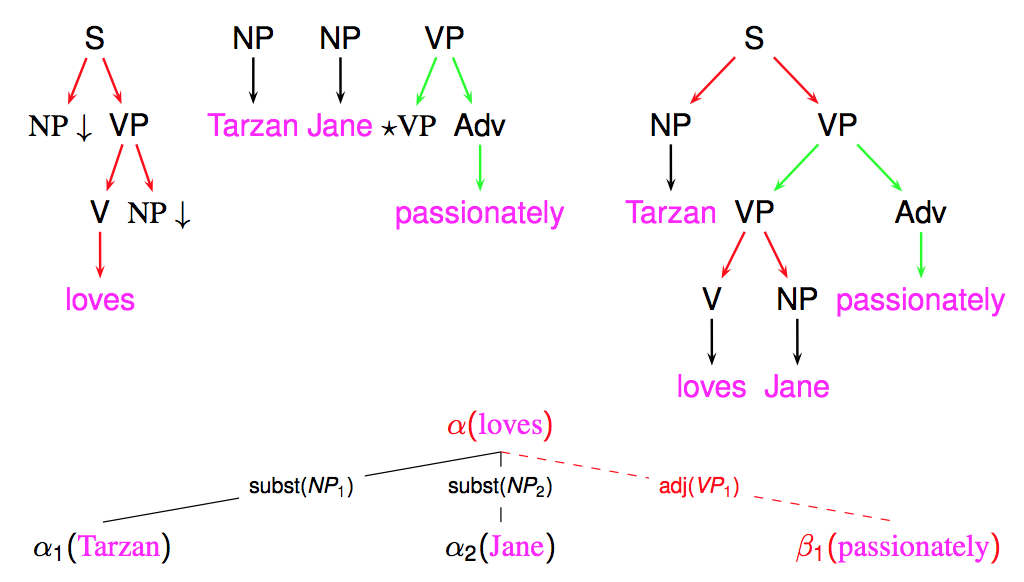Révisions
In our first examples with TAGs, we have seen that trees may be combined through substitution and adjoining to get complete parse trees.
These parse trees may be useful, but what is actually more useful are derivation trees (my opinion, but it may be discussed) ! A derivation tree keeps trace of all operations (substitution or adjoining), on which nodes these operations took place, and which elementary tree were used.
The following figure shows an example of such derivation tree

<
p class="align-center">
The interest of derivation tree partly stems from the observation that they better reflect an underlying semantic structure, in particular by relating a predicate (such as a verb) with its arguments (through substitution edges).
A derivation tree can also be more straightforwardly converted into a dependency tree, by establishing a dependency between the anchors of the trees that are the source and target of each derivation edge. For instance, in the previous example, a dependency edge will be established between loves and Tarzan. In the case of non-anchored trees (present in FRMG), a pseudo empty anchor will be positioned in the sentence (on the left-side of the span covered by the tree) and used as source or target of the dependency.
In practice, the FRMG parsers computes all possible parses for a sentences. But rather to return all possible derivation trees, it may return them under the form of a shared derivation forest, generally much much more compact ! The basic idea of shared forests is that subtrees may be shared but also contexts, leading to AND-OR trees.

However such AND-OR trees can also be represented under the form of a context-free grammars, with terminal and non-terminal decorated with spans over the sentence. Such derivation forest as CFG may be produced by frmg_parser with the option -forest (inherited from DyALog). However, nobody really wants to have a look at them !
A first step is to get a shared dependency forest, following the principles mentioned above (to convert a derivation tree into a dependency tree) but keeping as much as possible sharing. The results is the base for the native DepXML representation of the output of FRMG with the following XML elements (some of them being visible in the graphical view):
- clusters, (rectangle) used to list the words of the sentence (possibly with some redundancy because of segmentation/tokenization ambiguities provided by SxPipe)
- nodes, (ellipses) associated to a cluster, a part of speech, a lemma, and generally the tree that is anchored by the node. Because of ambiguities, several nodes may be associated to a same cluster
- edges (lines) linking a source node with a target node and with a label
- deriv (not visible) : because of ambiguities, a given edge may actually be used by several of the alternative derivations associated with the source node.
- op (not visible)
- hypertag (not visible)
Disambiguation with heuristic rules
Converting to various output schema/formats
Getting deeper representations
- Version imprimable
- Connectez-vous ou inscrivez-vous pour publier un commentaire
